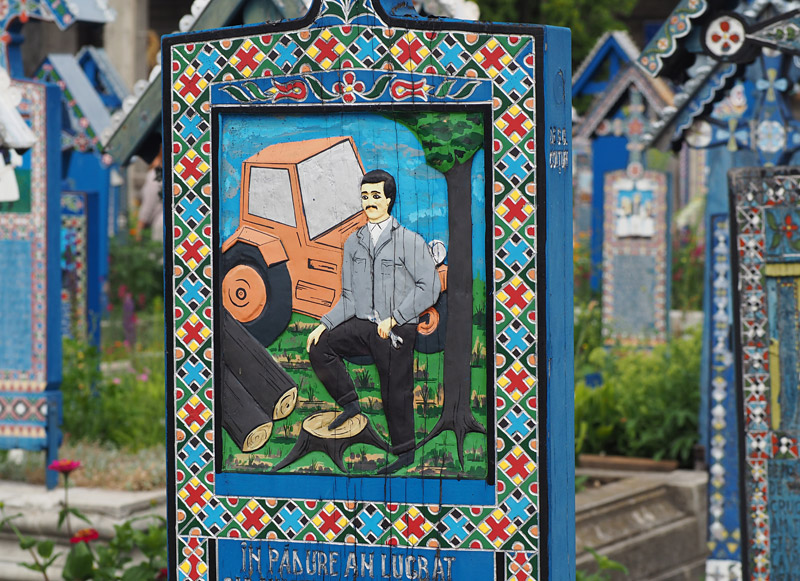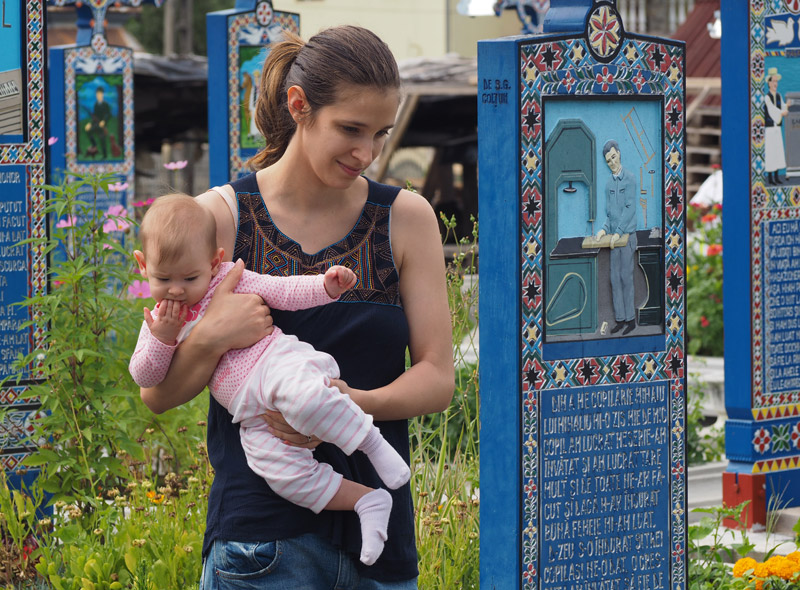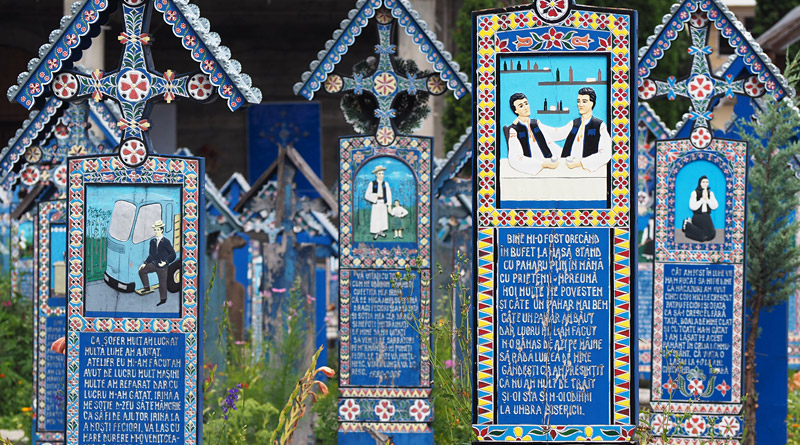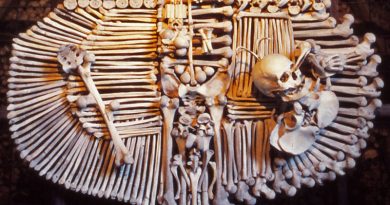The Merry Cemetery: Where folk art conquers grief
Anyone who tries to tell you death’s no laughing matter clearly hasn’t been to the Merry Cemetery.
Located in the village of Săpânţa, in an isolated corner of Romania, the Merry Cemetery is a folksy, charming and often funny celebration of villagers’ lives — and the way they died.
Each of its 800 graves is marked with a wooden cross painted an intense blue, the colour of the sky and hence the hue of heaven.
Below each cross is an oak plaque carved with a likeness of the deceased, then painted in bold primary colours and decorated with folk patterns, and a short poem.

Most of the carvings show the deceased engaged in their work or favourite pastimes. There are shepherds, tractor drivers, butchers, Communist party officials, publicans, bureaucrats and peasant farmers.
This is where I rest
Pop Ion Osu is my name
Though I am old I go up the hill to gather hay
When I get there I eat cheese and stew
And after that I take my mower and start working
Because this is what peasants do.
No cross is bigger or grander than another, with the farmer getting just as much attention as the judge. In Săpânţa at least, death really is the great leveller.
In many cultures people like to remember what was good about the dead and gloss over the bad. They also avoid dwelling on how their loved ones died, especially if it was gruesome or tragic.
Not so in Săpânţa, where the most striking graves are those which capture the villagers at their moment of death.
A young boy drowns in a river. A young girl is mown down by a speeding taxi. A shepherd is decapitated by a Hungarian bandit. A man too fond of tuica (Romania’s potent, home-made plum brandy) swigs from a bottle while the Grim Reaper beckons.

But it’s the epitaphs which really make the Merry Cemetery special. Granted, you need a translation app or a Romanian friend to understand them, but it’s worth the effort.
Each epitaph is a snapshot of the deceased written in simple rhyming verse. Some describe the person’s achievements in life; others focus on their foibles or means of death. Some are amusing, such as the man who begs his mother-in-law to stay in the ground:
Below this heavy cross
Lies my poor old mother-in-law.
If she’d lived another three days
I’d be lying here and she’d be reading this!
For those of you passing this way
Try not to wake her up.
Because if she comes by the house
Once again she’ll be taking issue with me.
Personally I intend to do my best
To see that she remains here
Safely in her grave.
 Others, however, are deeply poignant. Even in a merry cemetery it’s hard to find humour in the death of a child.
Others, however, are deeply poignant. Even in a merry cemetery it’s hard to find humour in the death of a child.
On the evening of June 9
I left to get some spring water.
My parents didn’t know.
I was brought home drowned.
No one knows what happened
They simply found me dead
In Săpânţa near a rock.
I leave the world sad behind me.
Oh, my poor short life
How little of it I got to live.
The origins of the Merry Cemetery, or Cimitirul Vesel in Romanian, go back to 1935 when woodworker Stan Ioan Pătraș started adding likenesses of the deceased and short, personalised poems to the crosses he was commissioned to make.
By the time of his death in 1977 he had completed hundreds of graves and become a minor celebrity in what was then still a strictly controlled Communist state.

All but a few of the epitaphs are written in the first person and in present tense, as if the deceased is leaving a final message. Many are written with a whimsical, peasant humour; a few are deeply unflattering. The families have no say in the poems yet none have ever complained, according to Pătraș’ successor, Dumitru Pop, in an interview in Atlas Obscura:
“It’s the real life of a person. If he likes to drink, you say that; if he likes to work, you say that. There’s no hiding in a small town. The families actually want the true life of the person to be represented on the cross.”
It’s hard to imagine a New Zealand family agreeing to a gravestone alluding to the deceased’s philandering ways:
Ioan Toaderu loved horses.
One more thing he loved very much:
To sit at a table in a bar
Next to someone else’s wife.
Some poems are far from complimentary about the lives they immortalise.
Pop Grigore is my name
I loved my tractor the most
And drowned my sorrows in the bottle.
All my life I was miserable and sad
Because my father left me when I was just a child.
Maybe this was my fate
To die young.
Others, like an epitaph for a three-year-old girl killed by a taxi, seethe with rage and grief.
May you burn in hell
Taxi driver from Sibiu!
In all of Romania
You could find no other place
But here, near our house
To stop and hit me
And bring grief to my parents.
For as long as they live
They will weep for me.
Săpânţa isn’t exactly hard to get to but it is a long way from anywhere, nestled against the Ukrainian border in the northwestern corner of Romania.
I got there by overnight train from the nearest big city, Cluj-Napoca, which involved changing trains at a deserted railway station at 3am.
From the end of the line, a pretty little town called Sighetu Maramaţiei, it was an easy 20km hitch-hike to the Merry Cemetery.
I’d only been trying to thumb a ride for a few minutes when a driver slammed on her brakes in the middle of an intersection and flung open a door. Her name was Natalia, the most glamorous police officer I’ve met. She not only drove me to the cemetery gates, she also insisted on paying my entry fee.
Before you assume Natalia is an aberration, that kind of hospitality is standard in rural Romania. It’s a part of the world which has preserved not just the way of life but also the generosity of another era.

I’m not sure what the dead of Săpânţa think about their final resting place becoming an off-beat tourist attraction, full of gawping tourists and Romanians chuckling to themselves as they read the epitaphs, but it’s certainly good business for the village.
When I visited the church was being rebuilt with shimmering mosaics and a soaring, needle-like spire. Many village homes doubled as souvenir shops and traffic jammed the square as tourist buses jostled for space with horse-drawn carts.
But even with the crowds and creeping commercialisation, Romania’s Merry Cemetery is a wonderful, whimsical work of folk art, where an honest carver harnessed the power of humour to transcend grief.

Since I was a little boy
I was known as Stan Ion Pătraș.
Listen to me, good people
And I will tell you no word of a lie.
For as long as I lived
I never wished anyone harm
Only good, as much as I could
No matter for whom.
From the age of 14
I had to work for a living.
Heavy work, in the forest
With axe and saw.
My father left for the war
From which he never returned
Leaving us behind, three small children,
In a world full of suffering.
I would have liked to live longer
To see my dreams come true.
Until yesterday I have had visitors
From sixty-two countries
And visits from many Heads of State.
From this time
Those who come here will find me gone.
I wish you all only the best
All you people who came to visit.
Getting there
 The closest city to the Merry Cemetery is Sighetu Maramaţiei (often shortened to Sighet), the capital of Maramureș region in northwest Romania. It’s so close to Ukraine you can walk from the town centre to the border crossing in less than half an hour — but it’s a long way from pretty much everywhere else.
The closest city to the Merry Cemetery is Sighetu Maramaţiei (often shortened to Sighet), the capital of Maramureș region in northwest Romania. It’s so close to Ukraine you can walk from the town centre to the border crossing in less than half an hour — but it’s a long way from pretty much everywhere else.
Daily trains to Sighet leave from Bucharest, Cluj-Napoca, Arad and Timișoara; the train from Bucharest North station takes 14 hours. Go to www.cfrcalatori.ro to check out the Romanian Railways schedule.
You can also fly to the nearest city, Baia Mare, or to Cluj-Napoca with the national airline, Tarom.
From Sighet you can catch a local bus or hitch-hike about 20km on the main road west to Săpânţa and the Merry Cemetery.
Where to stay
 I stayed in the delightful Cobwobs Hostel where I had a dorm room to myself. It’s a short walk from the railway station but so surrounded by animals, fruit trees and vegetable plots you could kid yourself you’re deep in the Romanian countryside.
I stayed in the delightful Cobwobs Hostel where I had a dorm room to myself. It’s a short walk from the railway station but so surrounded by animals, fruit trees and vegetable plots you could kid yourself you’re deep in the Romanian countryside.
Cobwobs doesn’t have a website but you can book via its Facebook page. You can find the hostel on Strada 22 Decembrie 1989, down a lane opposite the Lukoil service station, just west of the town centre.
Thanks to Doru of Papillon Travels and Tara Music for the translations. Check out the web pages by Atlas Obscura and Peter Kayafas if you want to read more about the Merry Cemetery.





Interesting stories from places I know (Romania, Czech, New Zealand), and others I would like to visit. Your personal touch and colourful introductions are a joy to read.
Tarja from Finland
Hello Tarja from Finland! Thanks for your message. I’m glad you are enjoying Ramblings. The three countries you mention are ones I have a special connection with (NZ, Czech Republic) or are among my favourite destinations (Romania). I haven’t been able to travel much in recent years but I hope to make up for that soon. I hope you also have some exciting trips to look forward to.
Ystävällisin terveisin (if that’s correct!)
Peter